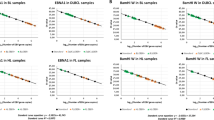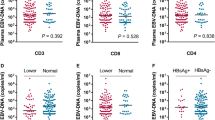Abstract
EPSTEIN–BARR virus-determined nuclear antigen (EBNA) can be detected in all EBV–DNA-carrying cells1,2. This includes Burkitt's lymphoma (BL) and nasopharyngeal carcinoma (NPC) tumour biopsy cells and EBV-carrying lymphoid lines1–5. Of the known EBV-associated antigens only EBNA is regularly associated with the presence of viral genetic material, no matter whether the cell line produces virus or not6,7. The composition and function of EBNA are largely unknown. Some recent reports suggest that EBNA is a protein that binds to DNA in vitro8,9 and is associated with chromosomes in vivo at least in part1. EBNA might be a virally determined or virally altered chromosomal protein of the non-histone type9. It is tempting to speculate that EBNA has a role in EBV-induced cell transformation (“immortalisation”10) and/or in the control of viral gene expression. There is a wide variation in the average number of EBV genome equivalents between different EBV–DNA-carrying cell lines. In virus non-producer cell lines this number is a better approximation of the true EBV genome number for individual cells than in virus producer lines, and is relatively stable over long periods of serial passage11. The EBNA content of EBV-containing cell lines also seems to vary between different cell lines, as judged visually in the fluorescence microscope. We have measured the amount of EBNA per cell, by quantitative immunofluorimetry in different cell lines, in parallel with determining the average number of EBV–DNA copies, and established a correlation between these two parameters.
This is a preview of subscription content, access via your institution
Access options
Subscribe to this journal
Receive 51 print issues and online access
$199.00 per year
only $3.90 per issue
Buy this article
- Purchase on Springer Link
- Instant access to full article PDF
Prices may be subject to local taxes which are calculated during checkout
Similar content being viewed by others
References
Reedman, B. & Klein, G. Int. J. Cancer 11, 499–520 (1973).
Lindahl, T., Klein, G., Reedman, B., Johansson, B. & Singh, S. Int. J. Cancer 13, 764–772 (1974).
Klein, G. et al. Proc. natn. Acad. Sci. U.S.A. 71, 4737–4741 (1974).
zur Hausen, H. & Schulte-Holthausen, H. Nature 227, 245–248 (1970).
Nonoyama, M. & Pagano, J. S. Nature new Biol. 223, 103–106 (1971).
Ernberg, I., Masucci, G. & Klein, G. Int. J. Cancer 17, 197–203 (1976).
Klein, G. Cold Spring Harb. Symp. quant. Biol. 39, 783–790 (1975).
Baron, D., Benz, W. C. & Strominger, J. L. in Epstein-Burr Virus Production, Concentration, and Purification, IARC Technical Report No. 75003, 257–262 (1975).
Luka, J., Siegert, W. & Klein, G. J. Virol. (in the press).
Miller, G., Robinson, I., Heston, L. & Lipman, M. Oncogenesis and Herpesviruses II (eds Epstein, de Thé & zur Hausen) 395–408 (IARC Scientific Publication No. 11 (1975).
Andersson, M. J. Virol. 16, 1345–1347 (1975).
Pulvertaft, R. J. V. J. clin. Path. 18, 261–273 (1965).
Klein, E., van Furth, R., Johansson, B., Ernberg, I. & Clifford, P. in Oncogenesis and Herpesviruses (eds Biggs, de Thé & Payne), 253–257 (IARC, Scientific Publication, 1972).
Klein, G., Dombos, L. & Gothoskar, B. Int. J. Cancer 10, 44–57 (1972).
Nyormoi, O., Klein, G., Adams, A. & Dombos, L. Int. J. Cancer 12, 396–408 (1973).
Nilsson, K. & Ponten, J. Int. J. Cancer 15, 321–341 (1975).
Ikawata, S. & Grace, J. T. N. Y. State med. J. 64, 2279–2282 (1964).
Durr, F. E., Monroe, J. H., Schmitter, R., Traul, K. A. & Hirshaut, Y. Int. J. Cancer 6, 436–449 (1970).
Klein, G., Giovanella, B., Westman, A., Stehlin, J. S. & Mumford, D. Intervirology 5, 319–334 (1975).
Jehn, U., Lindahl, T. & Klein, G. J. gen. Virol. 16, 409–442 (1972).
Killander, D., Klein, E. & Levin, A. Eur. J. Immun. 4, 327–332 (1974).
Brown, T. D. K., Ernberg, I. & Klein, G. Int. J. Cancer 15, 606–616 (1975).
Hampar, B. et al., Virology 62, 71–89 (1974).
Paul, J. Nature 238, 444–446 (1972).
Stein, G. S., Spelsberg, T. C. & Kleinsmith, L. J. Science 183, 817–824 (1974).
Author information
Authors and Affiliations
Rights and permissions
About this article
Cite this article
ERNBERG, I., ANDERSSON-ANVRET, M., KLEIN, G. et al. Relationship between amount of Epstein–Barr virus-determined nuclear antigen per cell and number of EBV–DNA copies per cell. Nature 266, 269–271 (1977). https://doi.org/10.1038/266269a0
Received:
Accepted:
Published:
Issue Date:
DOI: https://doi.org/10.1038/266269a0
This article is cited by
-
Early interactions between human cytomegalovirus and cells
Archives of Virology (1984)
-
Solid-Phase radioimmunoassays for Epstein-Barr virus-associated antigens
La Ricerca in Clinica e in Laboratorio (1982)
Comments
By submitting a comment you agree to abide by our Terms and Community Guidelines. If you find something abusive or that does not comply with our terms or guidelines please flag it as inappropriate.



